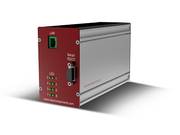 Laser Components
Laser Components

TEESS (TEmpe Electronics & Software Set) is an electronic drive module specially designed for LASER COMPONENTS’s IG series of complex x-InGaAs sensor arrays.
TEESS is a modular OEM set comprising a sensor board, a main processing and control unit (MPCU) in a metal casing, a sub-heatsink, wiring and user-friendly software. It was custom-made for the IG series of x-InGaAs line arrays by LASER COMPONENTS.
Thanks to its modular design, you may combine the components as required by your application, or use them in combination with your own parts.
The sensor board is a separate PCB board and physically houses the array and the heat sink. Its main task is to digitize the analog output signals and communicate them to the main unit. It comes with pre-fabricated holes for the integration of Zeiss and Polytec optics.
The Peltier cooling of the array creates heat that has to be dispersed by an external heatsink. A block of copper serves as an interface between those two components. It is advisable to attach it to the sensor array using a small amount of thermal epoxy. Both are then easily integrated into the sensor board.
The MPCU serves as a main connection between sensor unit and user PC. Its aluminum casing is equipped with all the necessary interfaces to provide fast and comfortable connection to any kind of instrument. Preprocessed data can quickly be sent to a PC app using LAN/WLAN connectivity.
-
- Casing: 6.5 cm x 10.5 cm x 17.0 cm
-
- Data buffer: 2,000 spectra
-
- Trigger Options: external digital input with up to 50 Hz; by time; by software
-
- Data transmission: Ethernet TCP/IP 10/100/1,000 Mbit/s
-
- Power consumption with TEC: 25 W
- Operating voltage: 5 VDC
The TEESS software has been written for plug and play operation of MPCU and sensor board. It serves three basic purposes:
-
- Organization of MPCU and sensor control
-
- Organization of data acquisition
- Data evaluation
